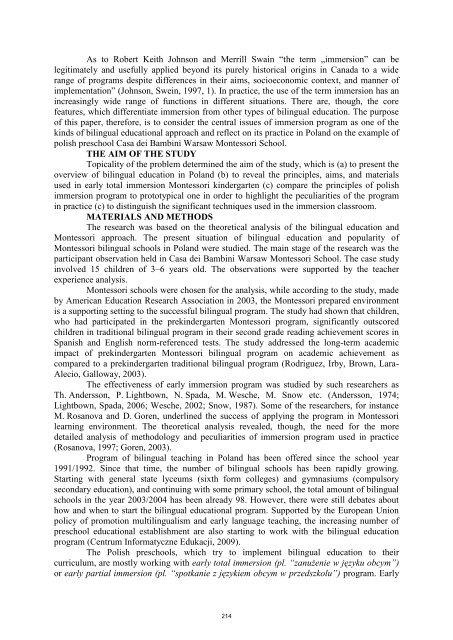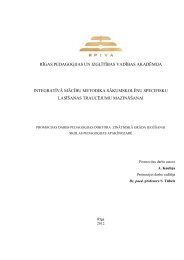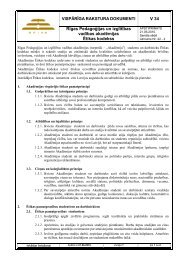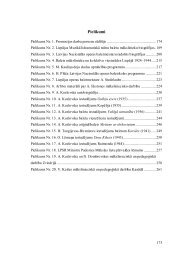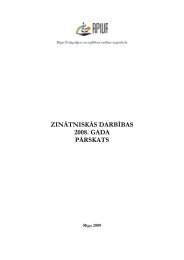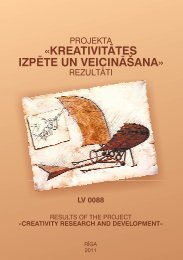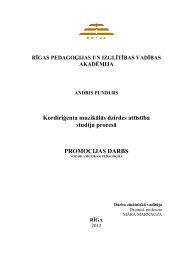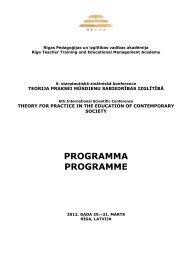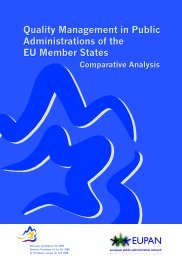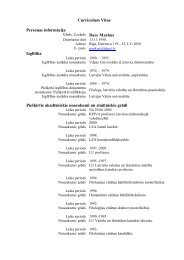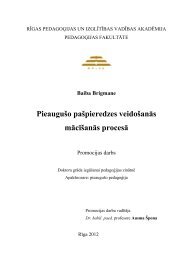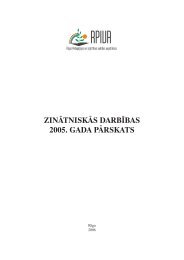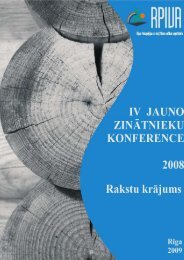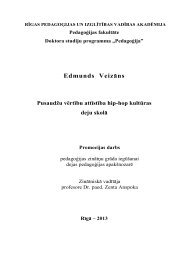saturs - rpiva
saturs - rpiva
saturs - rpiva
- No tags were found...
You also want an ePaper? Increase the reach of your titles
YUMPU automatically turns print PDFs into web optimized ePapers that Google loves.
As to Robert Keith Johnson and Merrill Swain “the term „immersion” can be<br />
legitimately and usefully applied beyond its purely historical origins in Canada to a wide<br />
range of programs despite differences in their aims, socioeconomic context, and manner of<br />
implementation” (Johnson, Swein, 1997, 1). In practice, the use of the term immersion has an<br />
increasingly wide range of functions in different situations. There are, though, the core<br />
features, which differentiate immersion from other types of bilingual education. The purpose<br />
of this paper, therefore, is to consider the central issues of immersion program as one of the<br />
kinds of bilingual educational approach and reflect on its practice in Poland on the example of<br />
polish preschool Casa dei Bambini Warsaw Montessori School.<br />
THE AIM OF THE STUDY<br />
Topicality of the problem determined the aim of the study, which is (a) to present the<br />
overview of bilingual education in Poland (b) to reveal the principles, aims, and materials<br />
used in early total immersion Montessori kindergarten (c) compare the principles of polish<br />
immersion program to prototypical one in order to highlight the peculiarities of the program<br />
in practice (c) to distinguish the significant techniques used in the immersion classroom.<br />
MATERIALS AND METHODS<br />
The research was based on the theoretical analysis of the bilingual education and<br />
Montessori approach. The present situation of bilingual education and popularity of<br />
Montessori bilingual schools in Poland were studied. The main stage of the research was the<br />
participant observation held in Casa dei Bambini Warsaw Montessori School. The case study<br />
involved 15 children of 3–6 years old. The observations were supported by the teacher<br />
experience analysis.<br />
Montessori schools were chosen for the analysis, while according to the study, made<br />
by American Education Research Association in 2003, the Montessori prepared environment<br />
is a supporting setting to the successful bilingual program. The study had shown that children,<br />
who had participated in the prekindergarten Montessori program, significantly outscored<br />
children in traditional bilingual program in their second grade reading achievement scores in<br />
Spanish and English norm-referenced tests. The study addressed the long-term academic<br />
impact of prekindergarten Montessori bilingual program on academic achievement as<br />
compared to a prekindergarten traditional bilingual program (Rodriguez, Irby, Brown, Lara-<br />
Alecio, Galloway, 2003).<br />
The effectiveness of early immersion program was studied by such researchers as<br />
Th. Andersson, P. Lightbown, N. Spada, M. Wesche, M. Snow etc. (Andersson, 1974;<br />
Lightbown, Spada, 2006; Wesche, 2002; Snow, 1987). Some of the researchers, for instance<br />
M. Rosanova and D. Goren, underlined the success of applying the program in Montessori<br />
learning environment. The theoretical analysis revealed, though, the need for the more<br />
detailed analysis of methodology and peculiarities of immersion program used in practice<br />
(Rosanova, 1997; Goren, 2003).<br />
Program of bilingual teaching in Poland has been offered since the school year<br />
1991/1992. Since that time, the number of bilingual schools has been rapidly growing.<br />
Starting with general state lyceums (sixth form colleges) and gymnasiums (compulsory<br />
secondary education), and continuing with some primary school, the total amount of bilingual<br />
schools in the year 2003/2004 has been already 98. However, there were still debates about<br />
how and when to start the bilingual educational program. Supported by the European Union<br />
policy of promotion multilingualism and early language teaching, the increasing number of<br />
preschool educational establishment are also starting to work with the bilingual education<br />
program (Centrum Informatyczne Edukacji, 2009).<br />
The Polish preschools, which try to implement bilingual education to their<br />
curriculum, are mostly working with early total immersion (pl. “zanużenie w języku obcym”)<br />
or early partial immersion (pl. “spotkanie z językiem obcym w przedszkolu”) program. Early<br />
214


